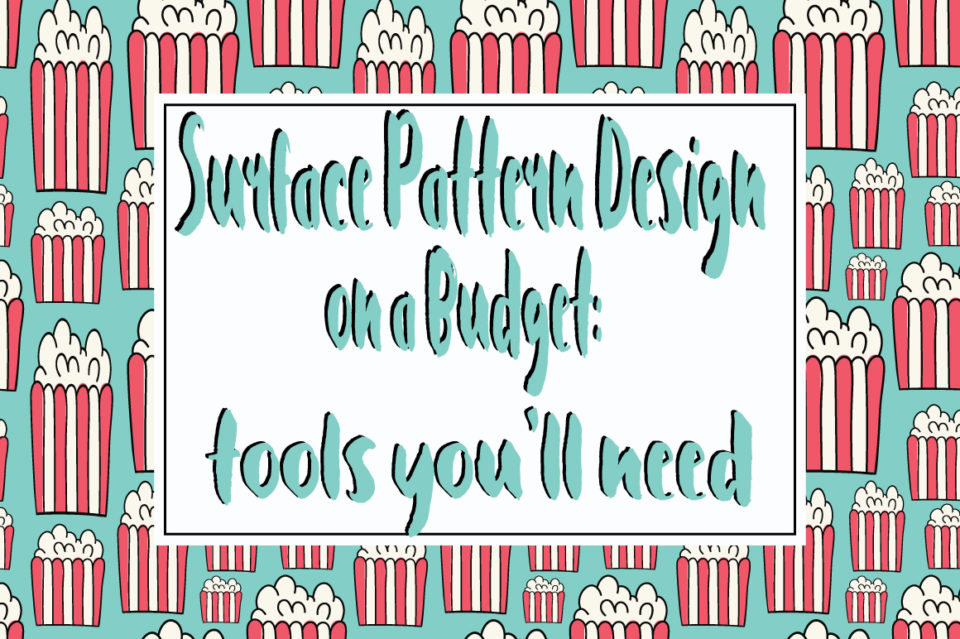
 When you are starting out in surface pattern design things begin to add up fast. Tablets, printers, scanners, etc. can get a bit pricey, but do you really need them? Here I will outline what I found useful when I started learning surface design and what tools are unnecessary when you are designing on a budget. So, let’s get started.
When you are starting out in surface pattern design things begin to add up fast. Tablets, printers, scanners, etc. can get a bit pricey, but do you really need them? Here I will outline what I found useful when I started learning surface design and what tools are unnecessary when you are designing on a budget. So, let’s get started.
What You Need:
A Computer:
This goes without saying but you absolutely need a computer. As far as which computer you should get, go with the cheapest. The one criteria you need to think about when buying a computer is storage. You are going to be creating a lot of patterns and, while you can always buy hard drives to put your patterns on, save yourself the hassle and buy your storage upfront.
Design Software:
The bulk of your money is going to go towards design software. It’s what turns your computer into a vehicle where you can create surface patterns so, although it is expensive, you need it. As far as software goes most illustrators like to use a combination of Adobe Illustrator and Photoshop, however, I have both Photoshop and Illustrator and I rarely use Photoshop. I would say 99.9% of your work can be done through Illustrator so you don’t need Photoshop, however, if you want both and are a student/work in a school Adobe offers a discount that allows you to get a handful of software for the price of one.
Pens/Pencils:
For those of you who like to draw different elements of your patterns by hand before you jump onto the computer you are going to need pens and pencils. Any pencil will do, but the pens you need are a little more specific if you want to use live trace. Adobe Illustrator’s live trace allows you to trace your sketches on the computer so you don’t have to go in and individually draw out each element. Live trace is a bit of a controversial topic among designers, as many designers believe it eliminates the hand drawn qualities of your drawings. While I don’t use live trace personally, I see the benefit of live trace in speeding up the design process. With live trace you really need good quality felt tip pens. Micron pens are great, but any other artist quality felt tip pen will work. I use Micron pens in size 03 or 05. You don’t want to get pens that are too thin because your scanner might not be able to pick up all of the details of the tinner lines.
Paper:
The only reason you would need to invest in high quality paper is if you were planning on using watercolor paint in your designs. If that is the case any hot press non-textured watercolor paper will work. For sketching out your ideas regular computer paper is fine. I also like using graph paper to help with symmetry, but it’s not necessary.
Classes:
What good is all of these tools if you don’t know how to use them to create surface patterns. When I was learning surface pattern design one of my favorite websites to visit was Skillshare.com. Skillshare does cost money ($15 dollars/mo or $120/yr), however, they always have deals where you get the first couple months free and that is really all you need to learn the basics of pattern design. Two of my favorite designers on skillshare are Bonnie Christine and Elizabeth Olwen.
What You Can Do Without:
Tablet:
Tablets are probably the most mentioned necessity that every surface pattern designer thinks you need but to start out it’s not necessary. I recently was gifted a Wacom Intuos Pro and find myself using Illustrator’s pen tool way more often then I do the Tablet. Tablets also happen to be one of the more expensive items on this list so if you don’t have the money to get a tablet up front, you can get by without it.
Scanner:
I almost never use my scanner. To be clear, with live trace you will need a scanner but you really only need a scanner for transferring your sketches to the computer, and for that, your phone’s camera is all you need.
Printer:
You don’t need to go out and buy a new, very expensive laser printer to become a surface pattern designer. To start out, you don’t need a printer at all. Colors look different on the computer then they do when printed so I only use my printer to test my patterns, but when you start out your main focus should be learning the fundamentals of pattern design. When you think you are ready to sell your designs that is when I would suggest getting a printer.
With any new project, don’t go all out at the beginning because you never know if you are going to stick with it. Adobe Illustrator is now paid for monthly so you might want to pay for a few months and see how it goes.
Are you already a surface pattern designer? What are your must have tools?
If you liked this post, why not share it! It lets me know what posts you like so I can make more posts like this.






Alis
Thank you! That’s great advice.
Kelcie Makes Patterns
You’re Welcome!
SHARON GILRAINE
Hi Kelvin,
I am just doing my research to Surface Pattern Design. I have worked very little on Adobe Illustrator, and it is Adobe Illustrator that has the Live Trace on it, do I have that right? I recall Live Trace tiny bit sounds like it would save time on one more small thing to move faster in production. Lol, I have no idea what I am talking about, but I try.
What is the difference between Adobe Illustrator on computer and Procreate which I could possibly use to learn SPD on as well; or is there more tools on Adobe compared to Procreate, which I would benefit more? I have only been playing with procreate and I am a Beginner.
All I really need, I think now is, a Computer with Adobe Illustrator – monthly to start, possibly Photoshop, micro pens and classes. So excited about this, have always loved patterns, colours, shadows etc all my life ….. best to do something that I have passion for.
I have scanner/printer combo already, and photo printer coming for my photos any day now.
I will look at Skillshare.com.
Found Bonnie Christine two weeks ago and her sight inspired me and I haven’t spoken to her yet; no coincidence that you mentioned her.
Kelcie, do you not work with Surface Pattern Design any longer? And how long were you engaged in SPD?
Hopefully this will not be the only time I have spoken to you.
Thank you, Sharon Gilraine
Kelcie Makes Patterns
Hey Sharon,
Welcome to the SPD community! To answer your questions, Adobe Illustrator does have live trace. Live trace is one of those polarizing topics in the design community because sometimes it can work great and save you a lot of time and sometimes it adds more work because you have to clean up your design. Adobe illustrator now has an app version on the iPad and I find it easier and faster to draw directly on the iPad and transfer the files to my computer. So the main difference between Adobe Illustrator and Procreate is that Adobe Illustrator works in vector images and Procreate works in raster images. What that essentially means is if you are creating a pattern in Adobe Illustrator you can scale the pattern up and down without the image getting blurry or losing quality. Raster images use pixels to create artwork so when you use Procreate you will notice that if you increase the size of the artwork inside of a pattern it will get blurry. Unless you know exactly what the pattern is going to be used for, vector patterns can be more useful because someone who wants to use your pattern on wallpaper can scale up the pattern as needed while those who use your pattern for fabric can scale it down. With Procreate you pretty much can only use your pattern around the size it was made or scaled down without losing a lot of quality. Having said that, I have been using Procreate a lot lately for my patterns because you have a lot more options when adding texture to your pattern. Photoshop is very similar to Procreate in the sense that they both use raster images. Many surface pattern designers use Photoshop to make patterns out of their watercolor artwork so if you plan on using watercolor art in your patterns, that is something to consider. I typically use photoshop to add my patterns to product mockups, however, there is a really good mockup generator called Smart Mockups that has some good free options for that purpose. I would suggest just getting Adobe Illustrator to start off with though because unless you can utilize the student/teacher edition of all of Adobe’s Creative Cloud apps, it can be pretty expensive to buy Adobe Illustrator and Photoshop each year. If you want to dip your toes in the vector design world without spending that much Affinity Designer is the best alternative. Right now affinity designer is 50% off so it’s $10 for the iPad app and $25 dollars for the desktop version. This is a one time purchase whereas with Adobe Illustrator you have to pay $20 dollars a month to get the software. It may be a good idea to try the free trials of both software to see which one you like better. There are a lot of tutorials on YouTube about how to create patterns in both Affinity designer and Adobe Illustrator so I would start there.
I am still doing surface pattern design, however, I haven’t been updating my website as much as I would like to lately. I am hoping to work more on creating new blog posts this year, but I mostly post my pattern designs on Instagram @kelciemakespatterns. I have been creating patterns for about 5 years now and it has been a slow process to improving my design abilities, however, this has been so much fun. You are going to love it. If you have anymore questions feel free to DM me on Instagram. That would be the easiest way to get ahold of me.
-Kelcie
SHARON GILRAINE
Sorry. Typo …Hi Kelcie !